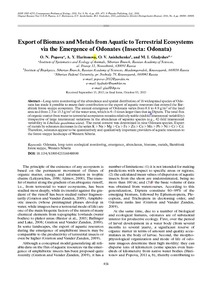Export of Biomass and Metals from Aquatic to Terrestrial Ecosystems via the Emergence of Dragonflies (Insecta: Odonata)
Скачать файл:
URI (для ссылок/цитирований):
https://elib.sfu-kras.ru/handle/2311/28026Автор:
Popova, O. N.
Haritonov, A. Yu.
Anishchenko, O. V.
Gladyshev, M. I.
Коллективный автор:
Институт фундаментальной биологии и биотехнологии
Кафедра водных и наземных экосистем
Дата:
2016-07Журнал:
Contemporary Problems of EcologyКвартиль журнала в Scopus:
Q3Квартиль журнала в Web of Science:
Q4Библиографическое описание:
Popova, O. N. Export of Biomass and Metals from Aquatic to Terrestrial Ecosystems via the Emergence of Dragonflies (Insecta: Odonata) [Текст] / O. N. Popova, A. Yu. Haritonov, O. V. Anishchenko, M. I. Gladyshev // Contemporary Problems of Ecology. — 2016. — Т. 9 (№ 4). — С. 458-473Аннотация:
Long-term monitoring of the abundance and spatial distribution of 18 widespread species of Odonata has made it possible to assess their contribution to the export of aquatic productivity that entered the Barabinsk forest-steppe ecosystem. The annual emergence of Odonata varies from 0.8 to 4.9 g/m2 of the land area and from 2.3 to 13.3 g/m2 of the water area, which is 4–5 times larger than that in Diptera. The total flux of organic matter from water to terrestrial ecosystems remains relatively stable (sixfold interannual variability) irrespective of large interannual variations in the abundance of separate species (e.g., 42-fold interannual variability in Libellula quadrimaculata). The metal content was determined in nine Odonata species. Export of metals by dragonflies decreases in the series K > Na > Mg > Ca > Fe > Zn > Cu > Mn > Pb > Ni > Cr > Cd. Therefore, odonates appear to be quantitatively and qualitatively important providers of aquatic resources to the forest-steppe landscape of Western Siberia.

